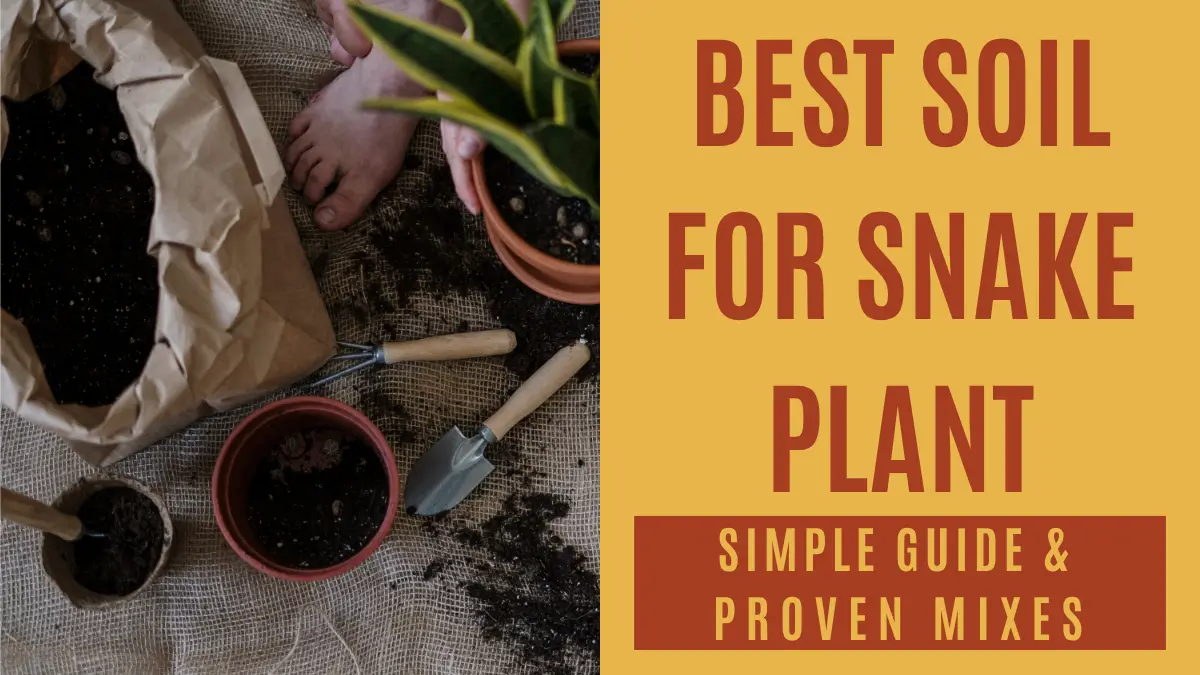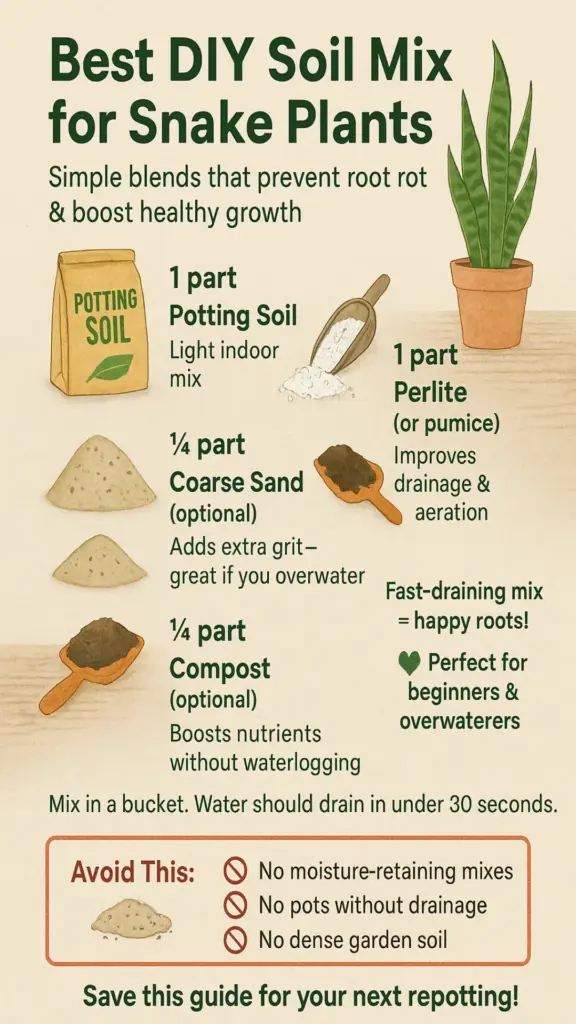Best Soil for Snake Plant: Simple Guide & Proven Mixes

If you’ve ever stood in a garden center, staring at shelves of potting mixes and wondering which is best for your snake plant, you’re not alone. Snake plants (Dracaena trifasciata, formerly Sansevieria) are famous for being tough and low-maintenance, but soil choice still plays a big role in their long-term health.
With countless recipes and opinions online, it’s easy to get overwhelmed. Do you really need a fancy five-ingredient mix? Or will a simple bag of cactus soil do the trick? In this guide, we’ll break down what actually works—based on real plant parent experience and science—so you can confidently choose (or mix) the best soil for your snake plant.
🌱 Quick Soil Scoop: What Your Snake Plant Actually Wants
No time to read it all? Here’s the dirt—literally!
🟢 Want it simple? Just grab a bag of cactus or succulent mix.
- ✔️ Drains fast
- ✔️ Ready to use
- ✔️ Perfect for beginners
💡 Top pick: Miracle-Gro Cactus, Palm & Citrus Potting Mix
🛠️ Prefer to DIY and save? I usually keep it simple: 1 scoop of potting soil and 1 scoop of perlite. That’s it. Fast-draining, no fuss.
- ✔️ Cheap and customizable
- ✔️ Boosts drainage
💡 Go heavier on perlite if you’re an “oops, I overwatered” type
🌾 Feeling adventurous? Try this gritty, grower-approved blend:
- 🟩 50% coarse sand
- 🟨 25% potting soil
- 🟫 25% compost
- A handful of gravel for bonus drainage
✔️ Mimics the snake plant’s natural habitat
✔️ Great for advanced plant parents
⚠️ Avoid: Moisture-control mixes, heavy soils, or pots with no drainage holes.
✅ Bottom Line: Keep it loose, airy, and fast-draining—and your snake plant will thrive, no drama required.
What Does a Snake Plant Need from Its Soil?
The most important thing to remember: snake plants need soil that drains quickly and doesn’t stay soggy. These plants are adapted to survive in dry, rocky regions of Africa, storing water in their thick leaves and roots.
Snake plants hate sitting in wet soil. If the pot doesn’t drain well, root rot can sneak in before you even notice a problem.
So what exactly does your snake plant need from its soil? Here’s a quick breakdown from years of trial (and error!) in my plant room.
- Excellent drainage: Water should move through the mix quickly.
- Aeration: The roots need air, not just moisture. Soil that’s too dense suffocates them.
- Moderate nutrients: Snake plants aren’t heavy feeders, but a little organic matter helps.
- pH balance: Slightly acidic to neutral (pH 5.5–7.5) is ideal.
Are snake plants really as forgiving as people say?
Yes, to a point. They can survive in less-than-perfect conditions, but thriving is another story. If you want your snake plant to grow well and avoid problems like yellow leaves or mushy roots, getting the soil right is key.
➡️ New to snake plants? Here’s my full care guide to get you started.
Best Soil Mixes for Snake Plant (What Most People Actually Use)
You don’t need to spend a fortune or mix a dozen ingredients. Here are the most popular, effective options—tested by real plant owners:
1. Cactus or Succulent Mix
A bagged cactus or succulent mix is often all you need. These mixes are designed to drain quickly and prevent root rot, making them a safe, easy choice for snake plants. Miracle-Gro Cactus, Palm & Citrus Potting Mix is a widely available option formulated for excellent drainage and trusted by many plant owners.
When is cactus mix enough?
- If you have just one or two plants and want convenience.
- If you don’t want leftover ingredients.
2. 50/50 Potting Soil and Perlite
Mixing equal parts regular indoor potting soil and perlite is a classic, budget-friendly recipe. Perlite (those little white volcanic rocks) increases drainage and keeps the soil airy. Espoma’s organic perlite is a trusted choice for improving soil aeration and drainage in all types of houseplants.
Why this works:
- Easy to find and inexpensive.
- Customizable: use more perlite for extra drainage if you tend to overwater.
3. Other Minimalist Options
Some plant parents add a bit of sand, compost, or even basic nursery soil to the mix. For a simple, effective homemade blend, you can use the following ratio—highly recommended by many experienced growers:
- 50% coarse sand
- 25% potting soil (or nursery soil)
- 25% compost
For even better drainage, throw in a small handful of gravel or small stones to the bottom of the pot or mix a bit into the soil. This helps excess water move away from the roots and prevents soggy spots.
I’ve used this mix for years because it checks every box—fast drainage from the sand and gravel, steady root support, and just enough nutrients from the compost to keep things balanced.
The result is a loose, gritty blend that mimics how snake plants grow in the wild—dry, airy, and never soggy. It’s the kind of setup that even perks up a plant that’s been a little forgotten.
Tip: Always use coarse sand (not fine play sand) to avoid compaction. Mix thoroughly and check that water drains quickly after watering.
Quick Comparison Table:
| Mix | Pros | Cons |
|---|---|---|
| Cactus/Succulent | Easy, ready to use, drains well | May be pricier per bag |
| 50/50 Potting + Perlite | Cheap, adjustable, widely available | Needs mixing |
| Potting Soil Only | Easiest, cheapest | Can hold too much water |
| Potting + Sand/Compost | Increases drainage, adds nutrients | Sand can compact if overused |
Snake Plant Soil Additives: Which Are Optional vs. Essential?
Over the years, I’ve seen (and tried!) all kinds of add-ins—bark, charcoal, worm tea, you name it. They’re fun to play with, but honestly? You don’t need them to make your snake plant happy. Here’s what’s optional and what’s essential:
- Essential: Add-ins that boost drainage—like perlite, pumice, coarse sand, or even chunky bark—are non-negotiable for happy snake plant roots.
- Optional: Charcoal (for odor and toxins), worm castings or compost (for nutrients), coco coir (as a peat alternative).
Add extras if you have them or want to experiment, but you don’t need a long list of ingredients. The simplest mixes work just fine for most people.
Best DIY Soil Mix for Snake Plants—Step-by-Step
For the Minimalist: One-Bag Solution
- Buy a bag of cactus or succulent mix.
- Fill your pot and plant your snake plant.
- Go easy on the water, and always wait until the top inch or two feels bone dry before reaching for that watering can.
For the DIYer: Easy Recipe
- 1 part indoor potting soil
- 1 part perlite (or pumice)
- Optional: If your mix feels a bit too dense, sprinkle in some coarse sand or bark chips. They help water flow better and keep roots breathing.
Combine ingredients in a bucket, mix thoroughly, and test by watering—water should drain through in under 30 seconds.
Tip: If you use compost or worm castings, add only a small amount (10–20%) to avoid holding excess moisture.
➡️ Curious about different varieties and how their needs vary? Here’s my favorite snake plant varieties guide.
Drainage: The Real Key to Snake Plant Success
No matter which soil mix you use, drainage is non-negotiable. Snake plants hate wet feet.
- If you can, always go for a pot with a drainage hole—your plant will thank you later.
- If you must use a pot without drainage, water very sparingly and use a very fast-draining mix. Some folks try a gravel layer at the bottom, but honestly, it’s a bit of a gamble. Proper soil and a draining pot work way better.
- Don’t use “moisture control” soils—they hold too much water.
How you water matters as much as what soil you use. Stick your finger in the soil—if the top 1–2 inches feel dry up to your first knuckle, you’re good to water.
For more on drainage and watering, see the detailed tips in this section before troubleshooting any plant issues.
Signs You’re Using the Wrong Soil for Your Snake Plant (and How to Fix It)
If your snake plant is struggling, soil could be the culprit. Watch for these warning signs:
- Yellowing or mushy leaves
- Roots that smell bad or look brown/black
- Soil stays wet for days after watering
- Slow or stunted growth
Quick fixes:
- Repot in a faster-draining mix (see recipes above)
- Add more perlite or sand to your existing soil
- Reduce watering frequency
➡️ Learn what to do in Snake Plant Drooping? Here’s Why.
➡️ Don’t forget seasonal tweaks: Snake Plant Winter Care
Repotting Tips for Snake Plants
When to repot:
- When roots circle the pot or poke out the drainage hole
- If soil stays soggy or the plant looks unhealthy
- Every 2–3 years, or sooner if needed
➡️Read our guide to learn how to repot a snake plant.
➡️ Also read: How often to water snake plant per season—because summer vs. winter care is not the same.

FAQs
Can I use regular potting soil only?
You can, but it’s risky—regular potting soil holds more water than snake plants like. Mix in some perlite or coarse sand for a quick drainage boost.
Is cactus mix safe for snake plants?
Absolutely. It’s often the easiest and best choice.
What if my pot has no drainage hole?
Water very carefully, use a very fast-draining mix, and consider repotting into a container with drainage if possible.
How often should I change the soil?
Every 2–3 years, or if you notice problems like root rot or compacted soil.
Cheapest way to get good soil for one plant?
Grab a small bag of cactus mix or stir a handful of perlite into your usual potting soil. No need to buy lots of extras.
Conclusion
Choosing the best soil for your snake plant doesn’t have to be complicated or expensive. Focus on good drainage and simple ingredients—don’t overthink it!
Whether you’re a beginner or an expert, remember: snake plants thrive on a little neglect and a lot of air around their roots. Keep it simple, watch your watering, and your snake plant will reward you with years of easy, beautiful growth.
✅ Want to see your snake plant truly thrive? Try one of these mixes and watch those tough leaves perk right up.
Try one of the simple soil mixes above—whether you go for a trusted cactus mix or blend your own with perlite, sand, and compost. You’ll see the difference in your plant’s health and growth.
Have questions, tips, or your own soil recipe to share? Drop a comment below! If you found this guide helpful, share it with a fellow plant lover or bookmark it for your next repotting session.
Related Guides You Might Love
